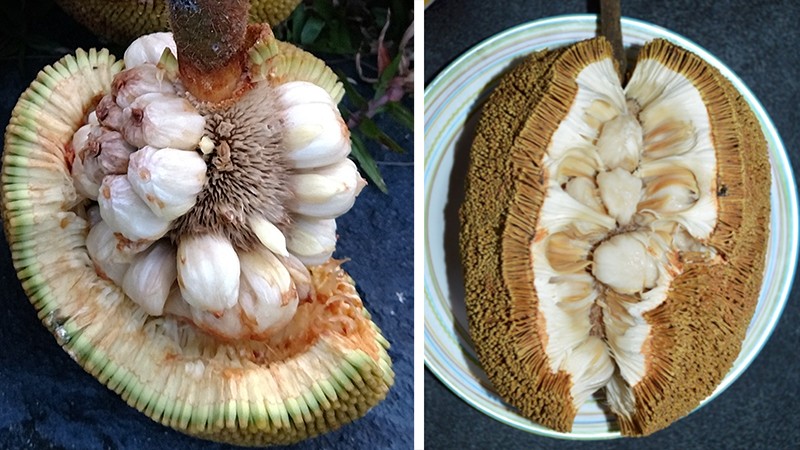Welcome to DU!
The truly grassroots left-of-center political community where regular people, not algorithms, drive the discussions and set the standards.
Join the community:
Create a free account
Support DU (and get rid of ads!):
Become a Star Member
Latest Breaking News
General Discussion
The DU Lounge
All Forums
Issue Forums
Culture Forums
Alliance Forums
Region Forums
Support Forums
Help & Search
Science
Related: About this forumOne tree or two? Genes confirm Iban traditional knowledge in Borneo
A news item in Nature: One tree or two? Genes confirm Iban traditional knowledge in Borneo
Subtitle:
Words in the languages of the Iban and Dusun people are the tip-off that a tree given a single scientific name is actually two species.
Freda Kreier, Nature News June 6, 2022.
It's probably open sourced, but an excerpt:
New species can hide in plain sight. A popular Asian fruit tree given the scientific name Artocarpus odoratissimus has been considered a single species by Western science for almost two centuries, despite some Indigenous peoples of Asia applying two names to the tree. But a genetic study1 now confirms that the evergreens that researchers have been lumping together as A. odoratissimus actually belong to two species — as reflected in their Indigenous names, each of which refers to a distinct variety of the tree.
This reclassification exemplifies how Indigenous knowledge can change and strengthen our understanding of biodiversity, says co-author Elliot Gardner, a botanist at the International Center for Tropical Botany in Miami, Florida.
“The underlying picture is that the knowledge that we are now corroborating with molecular markers was there all along,” says Matteo Dell’Acqua, a crop geneticist at the Sant’Anna School of Advanced Studies in Pisa, Italy, who was not involved in the study. “There is information we cannot access if we do not speak with traditional cultures.” The research was published on 6 June in Current Biology.
A tree of many names
A. odoratissimus was first incorporated into Western taxonomy in 1837 by Manuel Blanco, a Spanish friar living in the Philippines. Like other members of the genus Artocarpus, such as jackfruit (A. heterophyllus) or breadfruit (A. altilis), A. odoratissimus is cultivated across southeast Asia for its large, sweet fruit.
The tree was probably domesticated on the island of Borneo, which is a hotspot for Artocarpus diversity. Borneo today is split between the nations of Malaysia, Indonesia and Brunei, and is home to roughly 50 ethnic groups. Among them is the Iban, the largest ethnic group in the Malaysian state of Sarawak in northern Borneo.
In 2016, Gardner and his Malaysian colleagues were conducting field work in Sarawak when they noticed that the Iban field botanists were using two names to refer to the tree. The Iban botanists called A. odoratissimus trees with large fruit and leaves lumok, but dubbed trees with smaller, less sweet fruit pingan.
The researchers later realized that people belonging to another north Bornean ethnic group, the Dusun, also have separate names for the two types of A. odoratissimus. To see whether this difference could be found in the trees’ DNA, the researchers conducted a genetic study comparing lumok to pingan. The team found that the two tree types were related but were genetically distinct enough to be considered separate species...
This reclassification exemplifies how Indigenous knowledge can change and strengthen our understanding of biodiversity, says co-author Elliot Gardner, a botanist at the International Center for Tropical Botany in Miami, Florida.
“The underlying picture is that the knowledge that we are now corroborating with molecular markers was there all along,” says Matteo Dell’Acqua, a crop geneticist at the Sant’Anna School of Advanced Studies in Pisa, Italy, who was not involved in the study. “There is information we cannot access if we do not speak with traditional cultures.” The research was published on 6 June in Current Biology.
A tree of many names
A. odoratissimus was first incorporated into Western taxonomy in 1837 by Manuel Blanco, a Spanish friar living in the Philippines. Like other members of the genus Artocarpus, such as jackfruit (A. heterophyllus) or breadfruit (A. altilis), A. odoratissimus is cultivated across southeast Asia for its large, sweet fruit.
The tree was probably domesticated on the island of Borneo, which is a hotspot for Artocarpus diversity. Borneo today is split between the nations of Malaysia, Indonesia and Brunei, and is home to roughly 50 ethnic groups. Among them is the Iban, the largest ethnic group in the Malaysian state of Sarawak in northern Borneo.
In 2016, Gardner and his Malaysian colleagues were conducting field work in Sarawak when they noticed that the Iban field botanists were using two names to refer to the tree. The Iban botanists called A. odoratissimus trees with large fruit and leaves lumok, but dubbed trees with smaller, less sweet fruit pingan.
The researchers later realized that people belonging to another north Bornean ethnic group, the Dusun, also have separate names for the two types of A. odoratissimus. To see whether this difference could be found in the trees’ DNA, the researchers conducted a genetic study comparing lumok to pingan. The team found that the two tree types were related but were genetically distinct enough to be considered separate species...

The caption:
he pingan tree’s fruit (left) is distinct from the lumok tree’s (right), but Western scientists misclassified the two trees as one species for almost two centuries.Credit: left, Elias Ednie; right, Elliot Gardner
Cool...
InfoView thread info, including edit history
TrashPut this thread in your Trash Can (My DU » Trash Can)
BookmarkAdd this thread to your Bookmarks (My DU » Bookmarks)
0 replies, 854 views
ShareGet links to this post and/or share on social media
AlertAlert this post for a rule violation
PowersThere are no powers you can use on this post
EditCannot edit other people's posts
ReplyReply to this post
EditCannot edit other people's posts
Rec (4)
ReplyReply to this post